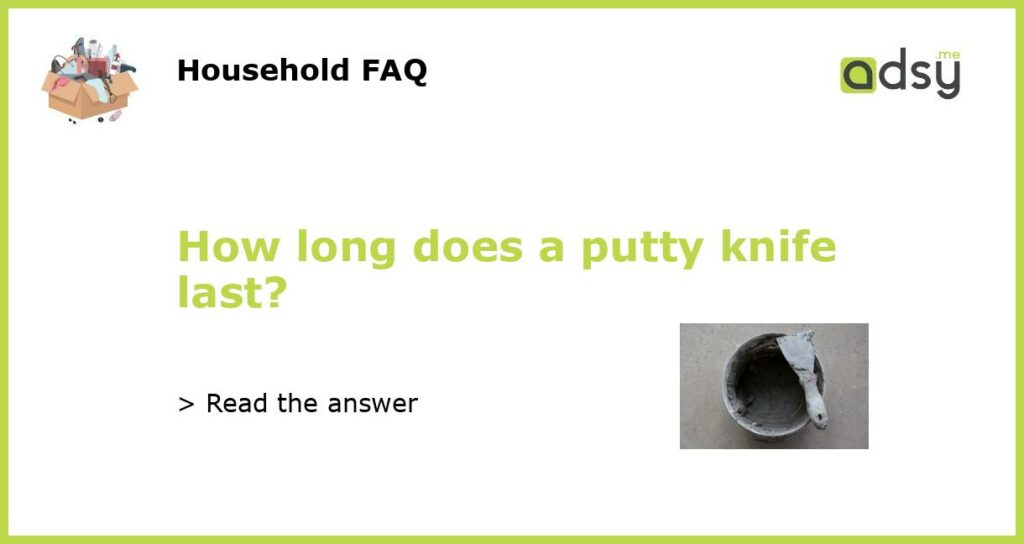Introduction
A putty knife is a versatile tool used for various purposes, from scraping off old paint to applying putty or caulk. However, like any tool, its longevity can vary depending on the quality of the knife and how it is used and maintained. In this article, we will explore how long a putty knife typically lasts and what factors can affect its lifespan.
Factors that Influence the Lifespan of a Putty Knife
Several factors can affect how long a putty knife lasts:
Quality of the Putty Knife
The quality of the putty knife itself plays a significant role in determining its lifespan. Higher quality putty knives are generally more durable and resistant to wear and tear. They often have a reinforced handle and a sturdy blade made from stainless steel or high carbon steel, which can withstand repetitive use without getting damaged or worn out quickly.
Frequency and Intensity of Use
The frequency and intensity of use also impact the longevity of a putty knife. If the knife is used frequently or for heavy-duty tasks such as removing layers of old paint, it may wear out more quickly. On the other hand, if the knife is only used occasionally for light tasks, it may last longer.
Maintenance and Care
The maintenance and care of a putty knife can significantly extend its lifespan. Proper cleaning and drying after each use help prevent corrosion and rust, which can damage the blade over time. Additionally, storing the knife in a dry and secure place away from moisture and other tools can prevent accidental damage.
Material and Coating of the Blade
The material and coating of the blade can also affect how long a putty knife lasts. Stainless steel blades are more resistant to rust and corrosion compared to carbon steel blades. Some putty knives also have a protective coating, such as Teflon, which reduces friction and prevents paint or other materials from sticking to the blade.
Lifespan of a Putty Knife
The lifespan of a putty knife can vary widely depending on the factors mentioned above. On average, a high-quality putty knife can last anywhere from several months to several years with proper use and maintenance.
If a putty knife is used frequently for heavy-duty tasks, it may wear out more quickly. In such cases, the blade may become dull or bent, and the handle may start to loosen or break. It is important to monitor the condition of the knife regularly and replace it if it becomes damaged or unsafe to use.
With occasional use for light tasks, a putty knife can last much longer. However, it is still essential to keep an eye on the blade’s condition and ensure it remains sharp and free from rust or corrosion.
Signs that a Putty Knife Needs Replacement
There are several signs that indicate a putty knife needs replacement:
Dull or Bent Blade
If the blade of the putty knife becomes dull or bent, it may not perform effectively. A dull blade can make scraping or applying putty more difficult and time-consuming. Similarly, a bent blade can cause uneven application or damage the surface being worked on. In such cases, it is advisable to replace the knife for optimal results.
Loose or Damaged Handle
A handle that is loose or damaged can affect the stability and control of the putty knife. If the handle starts to wobble or crack, it may compromise the overall functionality and safety of the tool. Replacing the knife with a new one in such situations is recommended.
Excessive Rust or Corrosion
If the blade of the putty knife shows signs of excessive rust or corrosion, it may be time for a replacement. Rust can weaken the blade and affect its performance, while corrosion can lead to pitting or roughness, making it difficult to achieve smooth finishes.
Conclusion
In conclusion, the lifespan of a putty knife depends on various factors including its quality, frequency and intensity of use, maintenance and care, and the material and coating of the blade. With proper use and maintenance, a high-quality putty knife can last for several months to years. However, signs such as a dull or bent blade, loose or damaged handle, and excessive rust or corrosion indicate that it may be time to replace the putty knife for optimal performance and safety. By understanding these factors and actively caring for the tool, users can extend the lifespan of their putty knives and ensure they remain effective for their intended purpose.






